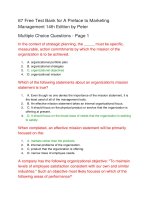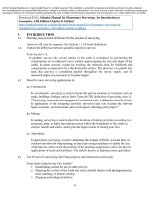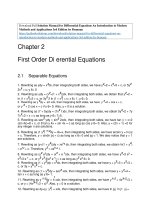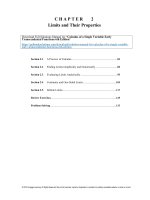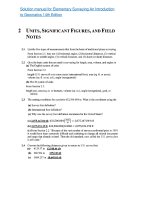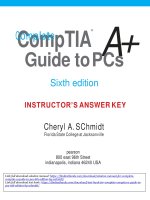Solution manual for mathematical proofs a transition to advanced mathematics 3rd edition by chartrand
Bạn đang xem bản rút gọn của tài liệu. Xem và tải ngay bản đầy đủ của tài liệu tại đây (191.52 KB, 10 trang )
Exercises for Chapter 1
Exercises for Section 1.1: Describing a Set
1.1 Only (d) and (e) are sets.
1.2 (a) A = {1, 2, 3} = {x ∈ S : x > 0}.
(b) B = {0, 1, 2, 3} = {x ∈ S : x ≥ 0}.
(c) C = {−2, −1} = {x ∈ S : x < 0}.
(d) D = {x ∈ S : |x| ≥ 2}.
1.3 (a) |A| = 5. (b) |B| = 11. (c) |C| = 51. (d) |D| = 2. (e) |E| = 1. (f) |F | = 2.
1.4 (a) A = {n ∈ Z : −4 < n ≤ 4} = {−3, −2, . . . , 4}.
(b) B = {n ∈ Z : n2 < 5} = {−2, −1, 0, 1, 2}.
(c) C = {n ∈ N : n3 < 100} = {1, 2, 3, 4}.
(d) D = {x ∈ R : x2 − x = 0} = {0, 1}.
(e) E = {x ∈ R : x2 + 1 = 0} = {} = ∅.
1.5 (a) A = {−1, −2, −3, . . .} = {x ∈ Z : x ≤ −1}.
(b) B = {−3, −2, . . . , 3} = {x ∈ Z : −3 ≤ x ≤ 3} = {x ∈ Z : |x| ≤ 3}.
(c) C = {−2, −1, 1, 2} = {x ∈ Z : −2 ≤ x ≤ 2, x = 0} = {x ∈ Z : 0 < |x| ≤ 2}.
1.6 (a) A = {2x + 1 : x ∈ Z} = {· · · , −5, −3, −1, 1, 3, 5, · · ·}.
(b) B = {4n : n ∈ Z} = {· · · , −8, −4, 0, 4, 8, · · ·}.
(c) C = {3q + 1 : q ∈ Z} = {· · · , −5, −2, 1, 4, 7, · · ·}.
1.7 (a) A = {· · · , −4, −1, 2, 5, 8, · · ·} = {3x + 2 : x ∈ Z}.
(b) B = {· · · , −10, −5, 0, 5, 10, · · ·} = {5x : x ∈ Z}.
(c) C = {1, 8, 27, 64, 125, · · ·} = {x3 : x ∈ N}.
1.8 (a) A = {n ∈ Z : 2 ≤ |n| < 4} = {−3, −2, 2, 3}.
(b) 5/2, 7/2, 4.
√
√
√
√
2)x + 2 2 = 0} = {x ∈ R : (x − 2)(x − 2) = 0} = {2, 2}.
√
√
(d) D = {x ∈ Q : x2 − (2 + 2)x + 2 2 = 0} = {2}.
(c) C = {x ∈ R : x2 − (2 +
(e) |A| = 4, |C| = 2, |D| = 1.
1.9 A = {2, 3, 5, 7, 8, 10, 13}.
B = {x ∈ A : x = y + z, where y, z ∈ A} = {5, 7, 8, 10, 13}.
C = {r ∈ B : r + s ∈ B for some s ∈ B} = {5, 8}.
1
Copyright © 2013 Pearson Education, Inc.
Exercises for Section 1.2: Subsets
1.10 (a) A = {1, 2}, B = {1, 2}, C = {1, 2, 3}.
(b) A = {1}, B = {{1}, 2}. C = {{{1}, 2}, 1}.
(c) A = {1}, B = {{1}, 2}, C = {1, 2}.
1.11 Let r = min(c − a, b − c) and let I = (c − r, c + r). Then I is centered at c and I ⊆ (a, b).
1.12 A = B = D = E = {−1, 0, 1} and C = {0, 1}.
1.13 See Figure 1.
2
r
..........
............................................. ...............
......
....
.... .....
....
...
... .....
...
...
1
..
...
...
.
.
...
..
5
...
....
....
.... 4 ....
.
...
..
...
...
3
...
..
.
...
.
...
.
.
.
..
8
...
...
.
.
.
.
... ....
....
..
... ..
...... 7
....
.......... ..................................................
..........
U
r
r
r
r
6
r
r
r
A
B
Figure 1: Answer for Exercise 1.13
1.14 (a) P(A) = {∅, {1}, {2}, {1, 2}}; |P(A)| = 4.
(b) P(A) = {∅, {∅}, {1}, {{a}}, {∅, 1}, {∅, {a}}, {1, {a}}, {∅, 1, {a}}}; |P(A)| = 8.
1.15 P(A) = {∅, {0}, {{0}}, A}.
1.16 P({1}) = {∅, {1}}, P(P({1})) = {∅, {∅}, {{1}}, {∅, {1}}}; |P(P({1}))| = 4.
1.17 P(A) = {∅, {0}, {∅}, {{∅}}, {0, ∅}, {0, {∅}}, {∅, {∅}}, A}; |P(A)| = 8.
1.18 P({0}) = {∅, {0}}.
A = {x : x = 0 or x ∈ P({0})} = {0, ∅, {0}}.
P(A) = {∅, {0}, {∅}, {{0}}, {0, ∅}, {0, {0}}, {∅, {0}}, A}.
1.19 (a) S = {∅, {1}}.
(b) S = {1}.
(c) S = {∅, {1}, {2}, {3}, {4, 5}}.
(d) S = {1, 2, 3, 4, 5}.
1.20 (a) False. For example, for A = {1, {1}}, both 1 ∈ A and {1} ∈ A.
(b) Because P(B) is the set of all subsets of the set B and A ⊂ P(B) with |A| = 2, it follows that
A is a proper subset of P(B) consisting of exactly two elements of P(B). Thus P(B) contains
at least one element that is not in A. Suppose that |B| = n. Then |P(B)| = 2n . Since 2n > 2,
it follows that n ≥ 2 and |P(B)| = 2n ≥ 4. Because P(B) ⊂ C, it is impossible that |C| = 4.
Suppose that A = {{1}, {2}}, B = {1, 2} and C = P(B) ∪ {3}. Then A ⊂ P(B) ⊂ C, where
|A| = 2 and |C| = 5.
2
Copyright © 2013 Pearson Education, Inc.
(c) No. For A = ∅ and B = {1}, |P(A)| = 1 and |P(B)| = 2.
(d) Yes. There are only three distinct subsets of {1, 2, 3} with two elements.
1.21 B = {1, 4, 5}.
Exercises for Section 1.3: Set Operations
1.22 (a) A ∪ B = {1, 3, 5, 9, 13, 15}.
(b) A ∩ B = {9}.
(c) A − B = {1, 5, 13}.
(d) B − A = {3, 15}.
(e) A = {3, 7, 11, 15}.
(f) A ∩ B = {1, 5, 13}.
1.23 Let A = {1, 2, . . . , 6} and B = {4, 5, . . . , 9}. Then A − B = {1, 2, 3}, B − A = {7, 8, 9} and
A ∩ B = {4, 5, 6}. Thus |A − B| = |A ∩ B| = |B − A| = 3. See Figure 2.
...................................
..................................................................
........
.......
........
......
.....
......
.....
.....
.....
....
.....
...
...
1
...
.
.
...
.
.
...
5
..
.... 4
.. 8
....
...
.
...
...
.
7
.
...
..
.
...
2
.
...
...
..
...
.
.
.
.
.
....
.
....
..
.
.
.
.
.
.
.
.
......
.
.
.
9 ...........
....... 6 ......
....... 3
....... ......
..
...........
..................................................................................
r
r
A
r
r
r
r
r
r
B
r
Figure 2: Answer for Exercise 1.23
1.24 Let A = {1, 2}, B = {1, 3} and C = {2, 3}. Then B = C but B − A = C − A = {3}.
1.25 (a) A = {1}, B = {{1}}, C = {1, 2}.
(b) A = {{1}, 1}, B = {1}, C = {1, 2}.
(c) A = {1}, B = {{1}}, C = {{1}, 2}.
1.26 (a) and (b) are the same, as are (c) and (d).
1.27 Let U = {1, 2, . . . , 8} be a universal set, A = {1, 2, 3, 4} and B = {3, 4, 5, 6}. Then A − B = {1, 2},
B − A = {5, 6}, A ∩ B = {3, 4} and A ∪ B = {7, 8}. See Figure 3.
1.28 See Figures 4(a) and 4(b).
1.29 (a) The sets ∅ and {∅} are elements of A.
(b) |A| = 3.
(c) All of ∅, {∅} and {∅, {∅}} are subsets of A.
(d) ∅ ∩ A = ∅.
3
Copyright © 2013 Pearson Education, Inc.
8
U
r
................................................................
..........
.......
....... ..........
......
.....
.....
.....
....
...
...
... 5
...
.
1 .......
.
...
....
.
4 ...
..
...
....
...
...
..
..
.
.
..
...
...
.
.
.
.
3
.... 2
....
.
. 6
.
.
.
.
.
.
.....
.....
.....
.......
.....
.......
............. .................................
...........................
..........
r
r
r
r
r
A
r
r
7
B
Figure 3: Answer for Exercise 1.27
A
A
.........................
............. ........ .....
................................
........ ..
............. ......................................... ....
........ ........ .............. .........................
.. . ... ... ... ... . ...
........................................................ .....
...
............... ................... ........
..
.................................................................
...................................... ...
..
............................. ...
..
.
C ................................................... ..........
............... .................
.......................... ......... C ∩
....
..
...
.............
...................................... ..........
.... .. .. ... ..... ...........
. ..
..... ..........................................
.
.
. .. .... ...... .. ..... .....
............ ... ...
...
...
........... .......
....
.
................
..
...
.
... ...
..
...
.
.
.
.
C ............................................. ............... B
.....
(C − B) .∪ A
B
(a)
(A − B)
(b)
Figure 4: Answers for Exercise 1.28
(e) {∅} ∩ A = {∅}.
(f) {∅, {∅}} ∩ A = {∅, {∅}}.
(g) ∅ ∪ A = A.
(h) {∅} ∪ A = A.
(i) {∅, {∅}} ∪ A = A.
1.30 (a) A = {x ∈ R : |x − 1| ≤ 2} = {x ∈ R : −2 ≤ x − 1 ≤ 2} = {x ∈ R : −1 ≤ x ≤ 3} = [−1, 3]
B = {x ∈ R : |x| ≥ 1} = {x ∈ R : x ≥ 1 or x ≤ −1} = (−∞, −1] ∪ [1, ∞)
C = {x ∈ R : |x + 2| ≤ 3} = {x ∈ R : −3 ≤ x + 2 ≤ 3} = {x ∈ R : −5 ≤ x ≤ 1} = [−5, 1]
(b) A ∪ B = (−∞, ∞) = R, A ∩ B = {−1} ∪ [1, 3],
B ∩ C = [−5, −1] ∪ {1}, B − C = (−∞, −5) ∪ (1, ∞).
1.31 A = {1, 2}, B = {2}, C = {1, 2, 3}, D = {2, 3}.
1.32 A = {1, 2, 3}, B = {1, 2, 4}, C = {1, 3, 4}, D = {2, 3, 4}.
1.33 A = {1}, B = {2}.
1.34 A = {1, 2}, B = {2, 3}.
1.35 Let U = {1, 2, . . . , 8}, A = {1, 2, 3, 5}, B = {1, 2, 4, 6} and C = {1, 3, 4, 7}. See Figure 5.
Exercises for Section 1.4: Indexed Collections of Sets
1.36
α∈A
Sα = S1 ∪ S3 ∪ S4 = [0, 3] ∪ [2, 5] ∪ [3, 6] = [0, 6].
α∈A
Sα = S1 ∩ S3 ∩ S4 = {3}.
4
Copyright © 2013 Pearson Education, Inc.
U
........
............ .........................................................
......
.......
. .
.....
.....
...... .........
....
....
....
...
...
....
...
.
...
..
..
...
...
.
.
2
...
...
..
..
.
.
.
...
...
.
.
.....
.
...
..
5
6
...
..
..
.
.
...
...
..
.
... .............................................
...
..
........
......
...
..
.
.
.
.
..
. .....
...
... ....
.
.
.
.
.
.
...
1
. .
...
.
...
...
... ....
...
...
...
..
...
...
...
...
... .....
....
.... ....
...
.......
.....
..... ..
....
.
.
.
.
.
.
........
.
3 ... ...
4 ...
... .................................................... ................. ...
..........
...
.
...
...
...
..
..
...
.
.
...
...
...
...
...
7
...
.....
...
......
.....
.
.
.
........
.
.
................................
C
A
B
r
r
r
r
r
8
r
r
r
Figure 5: Answer for Exercise 1.35
1.37
X∈S
X = A ∪ B ∪ C = {0, 1, 2, . . . , 5} and
1.38 (a)
α∈S
(b)
(c)
X∈S
X = A ∩ B ∩ C = {2}.
Aα = A1 ∪ A2 ∪ A4 = {1} ∪ {4} ∪ {16} = {1, 4, 16}.
α∈S
Aα = A1 ∩ A2 ∩ A4 = ∅.
α∈S
Bα = B1 ∪ B2 ∪ B4 = [0, 2] ∪ [1, 3] ∪ [3, 5] = [0, 5].
α∈S
Bα = B1 ∩ B2 ∩ B4 = ∅.
α∈S
Cα = C1 ∪ C2 ∪ C4 = (1, ∞) ∪ (2, ∞) ∪ (4, ∞) = (1, ∞).
α∈S
Cα = C1 ∩ C2 ∩ C4 = (4, ∞).
1.39 Since |A| = 26 and |Aα | = 3 for each α ∈ A, we need to have at least nine sets of cardinality 3
for their union to be A; that is, in order for α∈S Aα = A, we must have |S| ≥ 9. However, if we
let S = {a, d, g, j, m, p, s, v, y}, then α∈S Aα = A. Hence the smallest cardinality of a set S with
α∈S
Aα = A is 9.
1.40 (a)
(b)
(c)
5
i=1 A2i = A2 ∪ A4 ∪ A6 ∪ A8 ∪ A10 = {1, 3} ∪ {3, 5} ∪ {5, 7} ∪ {7, 9} ∪ {9, 11} = {1, 3, 5, . . . , 11}.
5
5
5
i=1 (Ai ∩ Ai+1 ) =
i=1 ({i − 1, i + 1} ∩ {i, i + 2}) =
i=1 ∅ = ∅.
5
5
5
i=1 (A2i−1 ∩ A2i+1 ) =
i=1 ({2i − 2, 2i} ∩ {2i, 2i + 2}) =
i=1 {2i} = {2, 4, 6, 8, 10}.
1.41 (a) {An }n∈N , where An = {x ∈ R : 0 ≤ x ≤ 1/n} = [0, 1/n].
(b) {An }n∈N , where An = {a ∈ Z : |a| ≤ n} = {−n, −(n − 1), . . . , (n − 1), n}.
1.42 (a) An = 1, 2 +
1
n
,
n∈N
(b) An = − 2n−1
n , 2n ,
1.43
An = [1, 3) and
n∈N
n∈N
An = (−2, ∞) and
r∈R+
Ar =
r∈R+ (−r, r)
= R;
r∈R+
Ar =
r∈R+ (−r, r)
= {0}.
An = [1, 2].
n∈N
An = (−1, 2).
1.44 For I = {2, 8}, | i∈I Ai | = 8. Observe that there is no set I such that | i∈I Ai | = 10, for in this
case, we must have either two 5-element subsets of A or two 3-element subsets of A and a 4-element
subset of A. In each case, not every two subsets are disjoint. Furthermore, there is no set I such
that | i∈I Ai | = 9, for in this case, one must either have a 5-element subset of A and a 4-element
subset of A (which are not disjoint) or three 3-element subsets of A. No 3-element subset of A
contains 1 and only one such subset contains 2. Thus 4, 5 ∈ I but there is no third element for I.
5
Copyright © 2013 Pearson Education, Inc.
1.45
n∈N
An =
1
n∈N (− n , 2
− n1 ) = (−1, 2);
n∈N
An =
1
n∈N (− n , 2
− n1 ) = [0, 1].
Exercises for Section 1.5: Partitions of Sets
1.46 (a) S1 is a partition of A.
(b) S2 is not a partition of A because g belongs to no element of S2 .
(c) S3 is a partition of A.
(d) S4 is not a partition of A because ∅ ∈ S4 .
(e) S5 is not a partition of A because b belongs to two elements of S5 .
1.47 (a) S1 is not a partition of A since 4 belongs to no element of S1 .
(b) S2 is a partition of A.
(c) S3 is not a partition of A because 2 belongs to two elements of S3 .
(d) S4 is not a partition of A since S4 is not a set of subsets of A.
1.48 S = {{1, 2, 3}, {4, 5}, {6}}; |S| = 3.
1.49 A = {1, 2, 3, 4}. S1 = {{1}, {2}, {3, 4}} and S2 = {{1, 2}, {3}, {4}}.
1.50 Let S = {A1 , A2 , A3 }, where A1 = {x ∈ N : x > 5}, A2 = {x ∈ N : x < 5} and A3 = {5}.
1.51 Let S = {A1 , A2 , A3 }, where A1 = {x ∈ Q : x > 1}, A2 = {x ∈ Q : x < 1} and A3 = {1}.
1.52 A = {1, 2, 3, 4}, S1 = {{1}, {2}, {3, 4}} and S2 = {{{1}, {2}}, {{3, 4}}}.
1.53 Let S = {A1 , A2 , A3 , A4 }, where
A1 = {x ∈ Z : x is odd and x is positive},
A2 = {x ∈ Z : x is odd and x is negative},
A3 = {x ∈ Z : x is even and x is nonnegative},
A4 = {x ∈ Z : x is even and x is negative}.
1.54 Let S = {{1}, {2}, {3, 4, 5, 6}, {7, 8, 9, 10}, {11, 12}} and T = {{1}, {2}, {3, 4, 5, 6}, {7, 8, 9, 10}}.
1.55 |P1 | = 2, |P2 | = 3, |P3 | = 5, |P4 | = 8, |P5 | = 13, |P6 | = 21.
1.56 (a) Suppose that a collection S of subsets of A satisfies Definition 1. Then every subset is
nonempty. Every element of A belongs to a subset in S. If some element a ∈ A belonged
to more than one subset, then the subsets in S would not be pairwise disjoint. So the collection satisfies Definition 2.
6
Copyright © 2013 Pearson Education, Inc.
(b) Suppose that a collection S of subsets of A satisfies Definition 2. Then every subset is nonempty
and (1) in Definition 3 is satisfied. If two subsets A1 and A2 in S were neither equal nor disjoint,
then A1 = A2 and there is an element a ∈ A such that a ∈ A1 ∩ A2 , which would not satisfy
Definition 2. So condition (2) in Definition 3 is satisfied. Since every element of A belongs
to a (unique) subset in S, condition (3) in Definition 3 is satisfied. Thus Definition 3 itself is
satisfied.
(c) Suppose that a collection S of subsets of A satisfies Definition 3. By condition (1) in Definition 3, every subset is nonempty. By condition (2), the subsets are pairwise disjoint. By
condition (3), every element of A belongs to a subset in S. So Definition 1 is satisfied.
Exercises for Section 1.6: Cartesian Products of Sets
1.57 A × B = {(x, x), (x, y), (y, x), (y, y), (z, x), (z, y)}.
1.58 A × A = {(1, 1), (1, {1}), (1, {{1}}), ({1}, 1), ({1}, {1}), ({1}, {{1}}), ({{1}}, 1), ({{1}}, {1}),
({{1}}, {{1}})}.
1.59 P(A) = {∅, {a}, {b}, A},
A × P(A) = {(a, ∅), (a, {a}), (a, {b}), (a, A), (b, ∅), (b, {a}), (b, {b}), (b, A)}.
1.60 P(A) = {∅, {∅}, {{∅}}, A},
A × P(A) = {(∅, ∅), (∅, {∅}), (∅, {{∅}}), (∅, A), ({∅}, ∅), ({∅}, {∅}), ({∅}, {{∅}}), ({∅}, A)}.
1.61 P(A) = {∅, {1}, {2}, A}, P(B) = {∅, B}, A × B = {(1, ∅), (2, ∅)},
P(A) × P(B) = {(∅, ∅), (∅, B), ({1}, ∅), ({1}, B), ({2}, ∅), ({2}, B), (A, ∅), (A, B)}.
1.62 {(x, y) : x2 + y 2 = 4}, which is a circle centered at (0, 0) with radius 2.
1.63 S = {(3, 0), (2, 1), (2, −1), (1, 2), (1, −2), (0, 3), (0, −3), (−3, 0), (−2, 1), (−2, −1), (−1, 2), (−1, −2)}.
See Figure 6.
1.64 A × B = {(1, 1), (2, 1)},
P(A × B) = {∅, {(1, 1)}, {(2, 1)}, A × B}
1.65 A = {x ∈ R : |x − 1| ≤ 2} = {x ∈ R : −1 ≤ x ≤ 3} = [−1, 3]
B = {y ∈ R : |y − 4| ≤ 2} = {y ∈ R : 2 ≤ y ≤ 6} = [2, 6],
A × B = [−1, 3] × [2, 6], which is the set of all points on and within the square bounded by x = −1,
x = 3, y = 2 and y = 6.
1.66 A = {a ∈ R : |a| ≤ 1} = {a ∈ R : −1 ≤ a ≤ 1} = [−1, 1]
B = {b ∈ R : |b| = 1} = {−1, 1},
A × B is the set of all points (x, y) on the lines y = 1 or y = −1 with x ∈ [−1, 1], while B × A is the
set of all points (x, y) on the lines x = 1 or x = −1 with y ∈ [−1, 1]. Therefore, (A × B) ∪ (B × A)
7
Copyright © 2013 Pearson Education, Inc.
.
.....
.. ...
r (0, 3)
(−1, 2)
(1, 2)
r
r
(2, 1)
(−2, 1)
r
r
(−3, 0)
(3, 0)
.....................................................................................................................................................................................................................................................................................
r
r
r
r
r (2, −1)
(−2, −1)
r
r
(−1, −2)
(1, −2)
r (0, −3)
Figure 6: Answer for Exercise 1.63
is the set of all points lying on (but not within) the square bounded by x = 1, x = −1, y = 1 and
y = −1.
Additional Exercises for Chapter 1
1.67 (a) A = {4k + 3 : k ∈ Z} = {. . . , −5, −1, 3, 7, 11, . . .}
(b) B = {5k − 1 : k ∈ Z} = {. . . , −6, −1, 4, 9, 14, . . .}.
1.68 (a) A = {x ∈ S : |x| ≥ 1} = {x ∈ S : x = 0}.
(b) B = {x ∈ S : x ≤ 0}.
(c) C = {x ∈ S : −5 ≤ x ≤ 7} = {x ∈ S : |x − 1| ≤ 6}.
(d) D = {x ∈ S : x = 5}.
1.69 (a) {0, 2, −2}
(b) { }
(e) {−2, 2}
1.70 (a) |A| = 6
(d) |D| = 0
(f) { }
(c) {3, 4, 5}
(d) {1, 2, 3}
(g) {−3, −2, −1, 1, 2, 3}.
(b) |B| = 0 (c) |C| = 3
(e) |E| = 10 (f) |F | = 20.
1.71 A × B = {(−1, x), (−1, y), (0, x), (0, y), (1, x), (1, y)}.
1.72 (a) (A ∪ B) − (B ∩ C) = {1, 2, 3} − {3} = {1, 2}.
(b) A = {3}.
(c) B ∪ C = {1, 2, 3} = ∅.
(d) A × B = {(1, 2), (1, 3), (2, 2), (2, 3)}.
8
Copyright © 2013 Pearson Education, Inc.
1.73 Let S = {{1}, {2}, {3, 4}, A} and let B = {3, 4}.
1.74 P(A) = {∅, {1}}, P(C) = {∅, {1}, {2}, C}. Let B = {∅, {1}, {2}}.
1.75 Let A = {∅} and B = P(A) = {∅, {∅}}.
1.76 Only B = C = ∅ and D = E.
1.77 U = {1, 2, 3, 5, 7, 8, 9}, A = {1, 2, 5, 7} and B = {5, 7, 8}.
1.78 (a) Ar is the set of all points in the plane lying on the circle x2 + y 2 = r2 .
r∈I
Ar = R × R (the plane) and
r∈I
Ar = ∅.
(b) Br is the set of all points lying on and inside the circle x2 + y 2 = r2 .
r∈I
Br = R × R and
r∈I
Br = {(0, 0)}.
(c) Cr is the set of all points lying outside the circle x2 + y 2 = r2 .
r∈I
Cr = R × R − {(0, 0)} and
r∈I
Cr = ∅.
1.79 Let A1 = {1, 2, 3, 4}, A2 = {3, 5, 6}, A3 = {1, 3}, A4 = {1, 2, 4, 5, 6}. Then |A1 ∩ A2 | = |A2 ∩ A3 | =
|A3 ∩ A4 | = 1, |A1 ∩ A3 | = |A2 ∩ A4 | = 2 and |A1 ∩ A4 | = 3.
1.80 (a) (i) Give an example of five sets Ai (1 ≤ i ≤ 5) such that |Ai ∩ Aj | = |i − j| for every two
integers i and j with 1 ≤ i < j ≤ 5.
(ii) Determine the minimum positive integer k such that there exist four sets Ai (1 ≤ i ≤ 4)
satisfying the conditions of Exercise 1.79 and |A1 ∪ A2 ∪ A3 ∪ A4 | = k.
(b) (i) A1 = {1, 2, 3, 4, 7, 8, 9, 10}
A2 = {3, 5, 6, 11, 12, 13}
A3 = {1, 3, 14, 15}
A4 = {1, 2, 4, 5, 6, 16}
A5 = {7, 8, 9, 10, 11, 12, 13, 14, 15, 16}.
(ii) The minimum positive integer k is 5. The example below shows that k ≤ 5.
Let A1 = {1, 2, 3, 4}, A2 = {1, 5}, A3 = {1, 4}, A4 = {1, 2, 3, 5}.
If k = 4, then since |A1 ∩ A4 | = 3, A1 and A4 have exactly three elements in common,
say 1, 2, 3. So each of A1 and A4 is either {1, 2, 3} or {1, 2, 3, 4}. They cannot both be
{1, 2, 3, 4}. Also, they cannot both be {1, 2, 3} because A3 would have to contain two of
1, 2, 3 and so |A3 ∩ A4 | ≥ 2, which is not true. So we can assume that A1 = {1, 2, 3, 4}
and A4 = {1, 2, 3}. However, A2 must contain two of 1, 2, 3 and so |A1 ∩ A2 | ≥ 2, which
is impossible.
1.81 (a) |S| = |T | = 10.
(b) |S| = |T | = 5.
(c) |S| = |T | = 6.
1.82 Let A = {1, 2, 3, 4}, A1 = {1, 2}, A2 = {1, 3}, A3 = {3, 4}. These examples show that k ≤ 4. Since
|A1 − A3 | = |A3 − A1 | = 2, it follows that A1 contains two elements not in A3 , while A3 contains two
elements not in A1 . Thus |A| ≥ 4 and so k = 4 is the smallest positive integer with this property.
9
Copyright © 2013 Pearson Education, Inc.
1.83 (a) S = {(−3, 4), (0, 5), (3, 4), (4, 3)}.
(b) C = {a ∈ B : (a, b) ∈ S} = {3, 4}
D = {b ∈ A : (a, b) ∈ S} = {3, 4}
C × D = {(3, 3), (3, 4), (4, 3), (4, 3)}.
1.84 A = {1, 2, 3}, B = {{1, 2}, {1, 3}, {2, 3}}, C = {{1}, {2}, {3}}.
D = P(C) = {∅, {{1}}, {{2}}, {{3}}, {{1}, {2}}, {{1}, {3}}, {{2}, {3}}, C}.
√
√
1.85 S = {x ∈ R : x2 + 2x − 1 = 0} = {−1 + 2, −1 − 2}.
√ √
√
√
A−1+√2 = {−1 + 2, 2}, A−1−√2 = {−1 − 2 − 2}.
(a) As = A−1−√2 and At = A−1+√2 .
√
√
√ √
√
√
√ √
As × At = {(−1 − 2, −1 + 2), (−1 − 2, 2), (− 2, 1 + 2), (− 2, 2)}.
√
√
(b) C = {ab : (a, b) ∈ B} = {−1, − 2 − 2, 2 − 2, −2}. The sum of the elements in C is −7.
10
Copyright © 2013 Pearson Education, Inc.

